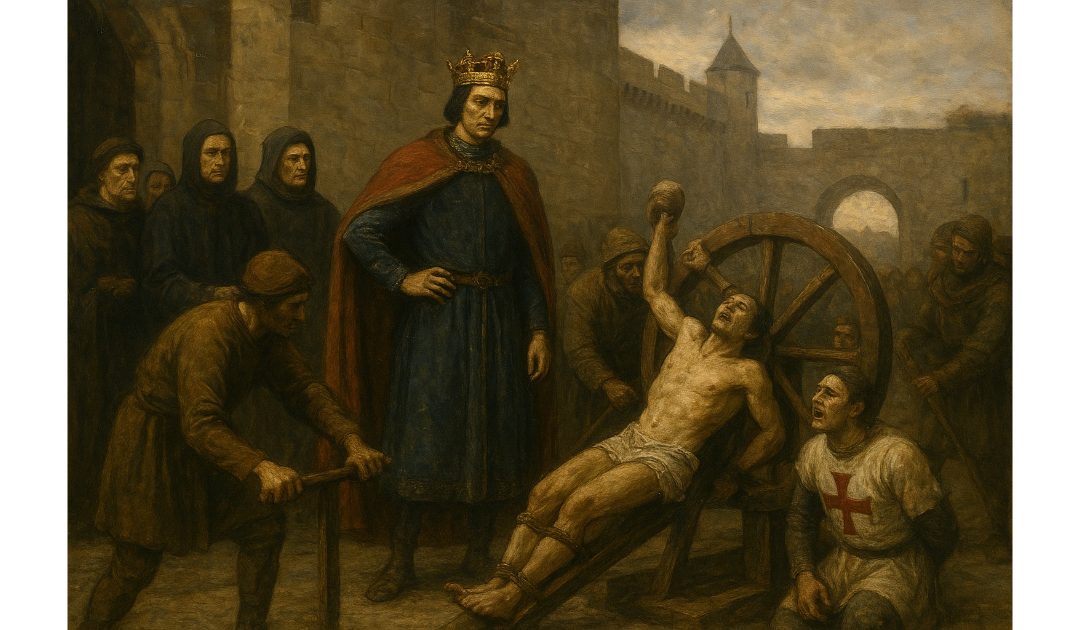On the 13th of October, 1307, hundreds of Knights Templar were arrested at dawn by King Philip the Fair. King Philip IV of France, known as Philip the Fair (Philippe le Bel), was born in 1268 and reigned from 1285 until his death in 1314. His moniker, ‘the Fair,’ referred to his strikingly handsome appearance, with blond hair and fine features; yet his reign was marked more by political cunning and administrative reforms than personal charm.
Philip ascended the throne following the death of his father, Philip III. His reign was characterised by efforts to consolidate royal power, assert control over the French clergy, and strengthen the monarchy’s financial foundations. Philip was a shrewd ruler who understood the significance of law and administration in reinforcing his authority.
One of Philip’s defining policies was his struggle with the papacy. The conflict with Pope Boniface VIII stemmed from Philip’s attempts to tax the clergy to fund military campaigns, an act the Pope opposed. This dispute escalated into a wider confrontation over the extent of secular authority over the Church. In 1303, Philip’s agents captured Boniface VIII in an event known as the ‘Outrage of Anagni.’ Although the Pope was soon released, he died shortly after, marking a symbolic victory for Philip. This altercation weakened papal authority and led to the Avignon Papacy, where the papal seat moved from Rome to Avignon, closely aligned with French interests.
Philip’s reign was also notable for his dealings with the Knights Templar. The Templars had grown wealthy and influential, managing financial transactions across Christendom. Philip, heavily indebted to the order due to his military expenditures, sought to eliminate this debt and neutralise their power. In 1307, he orchestrated a mass arrest of Templar members in France, charging them with heresy, blasphemy, and other crimes. Under duress and torture, many confessed to these accusations. The Templars were disbanded by Pope Clement V in 1312, and their last Grand Master, Jacques de Molay, was burned at the stake in 1314. This move not only erased Philip’s debts but also consolidated his control over valuable Templar assets.
On the domestic front, Philip IV pursued financial reforms to stabilise the crown’s revenue. He expanded the royal bureaucracy, employing skilled legal experts to administer laws and manage fiscal matters. His reign saw the establishment of the Estates-General in 1302, an assembly representing clergy, nobility, and commoners, designed to gather support for the king’s policies. However, this body held little real power compared to the monarchy.
Philip’s economic measures included debasing the currency to raise funds, which led to inflation and discontent among the populace. To counterbalance fiscal strain, he imposed taxes on the clergy and Jewish communities. In 1306, he expelled the Jewish population from France, seizing their property and reinforcing royal coffers.
Philip’s foreign policy was aggressive, seeking to expand French influence. He engaged in conflicts with England, particularly over the Duchy of Gascony, leading to tensions that would later culminate in the Hundred Years’ War. His marriage to Joan I of Navarre brought the Kingdom of Navarre and significant lands in Champagne under French control, strengthening the monarchy’s territorial hold.
Philip IV’s reign was a pivotal period in the centralisation of French royal power. His reliance on legalism, bureaucratic governance, and financial manipulation laid foundations for the modern French state. However, his heavy-handed methods fostered resentment among various societal groups.
His death in 1314 marked the end of an era. His immediate successors, his three sons—Louis X, Philip V, and Charles IV—each faced difficulties maintaining the strong royal authority he had established, leading to political instability. This turbulence ultimately contributed to the outbreak of the Hundred Years’ War between France and England.
Philip IV’s legacy is complex. He was a ruler of remarkable administrative talent and political acumen, whose reign significantly shaped medieval France. His conflicts with the Church and the suppression of the Knights Templar reflected his determination to assert royal supremacy. Yet, his financial policies and harsh measures against minority groups revealed the darker facets of his governance.

